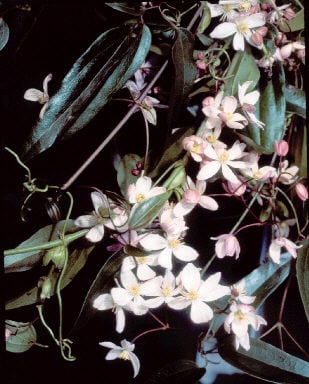Clematis 'Apple Blossom' (Ar)
clematis 'Apple Blossom'
A large, vigorous evergreen climber with leathery, bright, dark green trifoliate leaves, tinged bronze when young, and fragrant white flowers tinged pink are 5-6.5cm across opening from deep pink buds, and fading to near white, early to mid spring.

Buy this plant
Size
Ultimate height
4–8 metresTime to ultimate height
5–10 yearsUltimate spread
1.5–2.5 metresGrowing conditions
Moisture
Moist but well–drainedpH
Alkaline, NeutralColour & scent
| Stem | Flower | Foliage | Fruit | |
| Spring | Pink | Bronze Green | ||
|---|---|---|---|---|
| Summer | Pink | Green | ||
| Autumn | Green | |||
| Winter | Green |
Position
- Full sun
- Partial shade
Aspect
South–facing or West–facing
Exposure
Sheltered Hardiness
H4Botanical details
- Family
- Ranunculaceae
- Native to GB / Ireland
- No
- Foliage
- Evergreen
- Habit
- Climbing
- Potentially harmful
- Skin irritant. Wear gloves and other protective equipment when handling. Pets (rabbits): Harmful if eaten. For further information and contact numbers regarding pets, see the HTA guide to potentially harmful plants
- Genus
Clematis can be deciduous or evergreen shrubs or herbaceous perennials, mostly climbing by twining leaf-stalks, and often with showy flowers. Some have attractive fluffy seedheads in autumn
- Name status
Accepted
- Horticultural Group
- Armandii Group clematis are evergreen woody climbers with leathery leaves and single white or pink flowers, in late winter and spring, in the leaf axils of the previous year's growth
How to grow
Cultivation
Vigorous clematis for a warm south or south-west facing wall, with protection from cold winds. Grow in any fertile, well-drained soil. Plant with the crown 5-8cm (2-3in) deep to encourage shoots to grow from below ground level. Keep the base shaded and cool by the careful positioning of plants or a layer of pebbles or flat stones. See clematis cultivation for more advice
Propagation
Propagate by layering, semi-hardwood cuttings or hardwood cuttings
Suggested planting locations and garden types
- Cottage and informal garden
- Mediterranean climate plants
- Flower borders and beds
- Wall side borders
Pruning
Pests
May be susceptible to aphids, snails and caterpillars; petals may be eaten by earwigs
Diseases
May be susceptible to honey fungus (rarely), clematis wilt and clematis slime flux
Get involved
The Royal Horticultural Society is the UK’s leading gardening charity. We aim to enrich everyone’s life through plants, and make the UK a greener and more beautiful place.